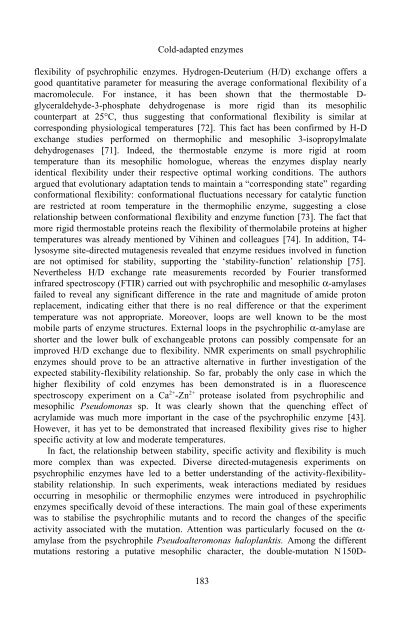Physics And Chemistry Basis Of Biotechnology - De Cuyper - tiera.ru
Physics And Chemistry Basis Of Biotechnology - De Cuyper - tiera.ru
Physics And Chemistry Basis Of Biotechnology - De Cuyper - tiera.ru
Create successful ePaper yourself
Turn your PDF publications into a flip-book with our unique Google optimized e-Paper software.
Cold-adapted enzymes<br />
flexibility of psychrophilic enzymes. Hydrogen-<strong>De</strong>uterium (H/D) exchange offers a<br />
good quantitative parameter for measuring the average conformational flexibility of a<br />
macromolecule. For instance, it has been shown that the thermostable Dglyceraldehyde-3-phosphate<br />
dehydrogenase is more rigid than its mesophilic<br />
counterpart at 25°C, thus suggesting that conformational flexibility is similar at<br />
corresponding physiological temperatures [72]. This fact has been confirmed by H-D<br />
exchange studies performed on thermophilic and mesophilic 3-isopropylmalate<br />
dehydrogenases [71]. Indeed, the thermostable enzyme is more rigid at room<br />
temperature than its mesophilic homologue, whereas the enzymes display nearly<br />
identical flexibility under their respective optimal working conditions. The authors<br />
argued that evolutionary adaptation tends to maintain a “corresponding state” regarding<br />
conformational flexibility: conformational fluctuations necessary for catalytic function<br />
are restricted at room temperature in the thermophilic enzyme, suggesting a close<br />
relationship between conformational flexibility and enzyme function [73]. The fact that<br />
more rigid thermostable proteins reach the flexibility of thermolabile proteins at higher<br />
temperatures was already mentioned by Vihinen and colleagues [74]. In addition, T4lysosyme<br />
site-directed mutagenesis revealed that enzyme residues involved in function<br />
are not optimised for stability, supporting the ‘stability-function’ relationship [75].<br />
Nevertheless H/D exchange rate measurements recorded by Fourier transformed<br />
infrared spectroscopy (FTIR) carried out with psychrophilic and mesophilic α-amylases<br />
failed to reveal any significant difference in the rate and magnitude of amide proton<br />
replacement, indicating either that there is no real difference or that the experiment<br />
temperature was not appropriate. Moreover, loops are well known to be the most<br />
mobile parts of enzyme st<strong>ru</strong>ctures. External loops in the psychrophilic α-amylase are<br />
shorter and the lower bulk of exchangeable protons can possibly compensate for an<br />
improved H/D exchange due to flexibility. NMR experiments on small psychrophilic<br />
enzymes should prove to be an attractive alternative in further investigation of the<br />
expected stability-flexibility relationship. So far, probably the only case in which the<br />
higher flexibility of cold enzymes has been demonstrated is in a fluorescence<br />
spectroscopy experiment on a Ca 2+ -Zn 2+ protease isolated from psychrophilic and<br />
mesophilic Pseudomonas sp. It was clearly shown that the quenching effect of<br />
acrylamide was much more important in the case of the psychrophilic enzyme [43].<br />
However, it has yet to be demonstrated that increased flexibility gives rise to higher<br />
specific activity at low and moderate temperatures.<br />
In fact, the relationship between stability, specific activity and flexibility is much<br />
more complex than was expected. Diverse directed-mutagenesis experiments on<br />
psychrophilic enzymes have led to a better understanding of the activity-flexibilitystability<br />
relationship. In such experiments, weak interactions mediated by residues<br />
occurring in mesophilic or thermophilic enzymes were introduced in psychrophilic<br />
enzymes specifically devoid of these interactions. The main goal of these experiments<br />
was to stabilise the psychrophilic mutants and to record the changes of the specific<br />
activity associated with the mutation. Attention was particularly focused on the αamylase<br />
from the psychrophile Pseudoalteromonas haloplanktis. Among the different<br />
mutations restoring a putative mesophilic character, the double-mutation N 150D-<br />
183












